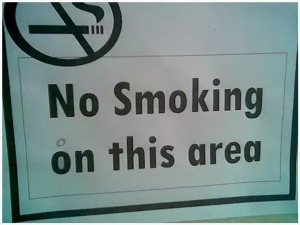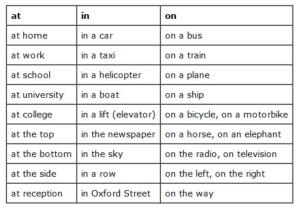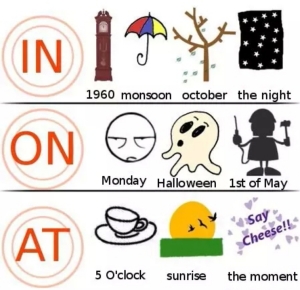
The same mistake happened with the sign above. The sign should say “No smoking in this area”, NOT “No smoking on this area”.
How to talk about locations?

One of the most confusing grammar points for English learners is trying to figure out whether to use AT, ON, or IN when you talk about locations and places. I hope after reading this explanation, you will no longer be confused.
When do I use IN?
Use the preposition IN when you are talking about something that you can physically enter or that you can place something inside of such as:
• I am standing in the room (I can enter a room)
• I put the chicken in the oven
• My wallet is in my pocket.
• How long did you live in Jakarta?
When do I use AT?
You should use AT when you want to indicate a specific location or place.
For example:
• We wait for bus number 39 at the bus stop
• I buy my groceries at the farmer’s market
• Turn left at the end of the block
• Please wait at my desk if you want to speak with me.
• The teacher asked the students to sit at their own desk.
Remember you “sit at the desk” and not “sit on the desk”
— “sit at the desk” means you sit on the chair near the desk and “sit on the desk” means you sit on top of it.
When do I use ON?
We use ON when we want to say that something is resting on a vertical or horizontal surface.
We can say:
• We sat on the bench
• I put the poster on the wall
• Put your feet on the floor
• Drive one mile and store will be on your left.
• What’s on the menu?
How to talk about time?

This is an easy way to remember the prepositions of TIME:
• AT is for small times
at 2 pm; at the moment; at that time; at lunchtime; at midnight; at midday
• ON is for days:
on May 30; on Thursday morning; on New Year’s Eve; on weekdays
• IN isfor big times:
in 2014; in December; in the winter; in my life; in the 18th century
I hope you will understand the use of at – on – in as prepositions of place and time after reading my explanation in this section. Leave me a reply should you need more explanation on this subject.
. In a Newspaper or on a Newspaper
. In a Newspaper or on a Newspaper
More examples:
• I read that news in the newspaper.
• I saw that news on TV.
• I heard that news on the radio.
• I read that story in the book on page 57. (The story is inside the book. The story is on [the surface] page 57.)
• I saw that news on TV.
• I heard that news on the radio.
• I read that story in the book on page 57. (The story is inside the book. The story is on [the surface] page 57.)
Note:
A systematic analysis of the occurrence of the prepositions “in” and “on” in their core usage as indicators of time and place, helps us establish some key meaning concepts which will aid us in identifying and explaining their extended meanings
A systematic analysis of the occurrence of the prepositions “in” and “on” in their core usage as indicators of time and place, helps us establish some key meaning concepts which will aid us in identifying and explaining their extended meanings
ON – is a mechanism which usually describes something in relation to a second, often linear dimension, hence it relates to the calendar (days and dates) and surfaces or lines.
• Write the number down on a piece of paper.
• The picture is on page 10.
• Write the number down on a piece of paper.
• The picture is on page 10.
IN – is a mechanism for describing something in relation to the things that surround it in time or space, hence it relates to periods of time and three dimensional spaces or containers. It is also used to show when something is part of something else.
• I’ve found one or two spelling mistakes in your essay.
On Your Mind Vs. In Your Mind
• I’ve found one or two spelling mistakes in your essay.
On Your Mind Vs. In Your Mind



No comments:
Post a Comment